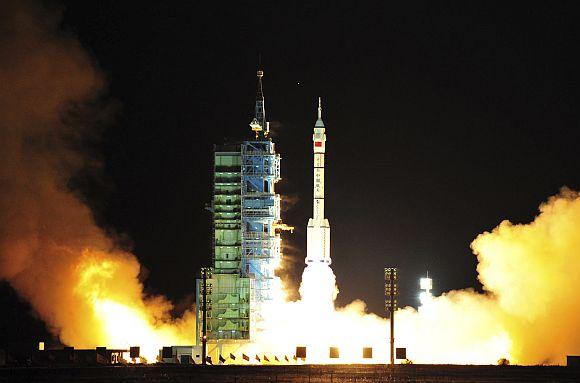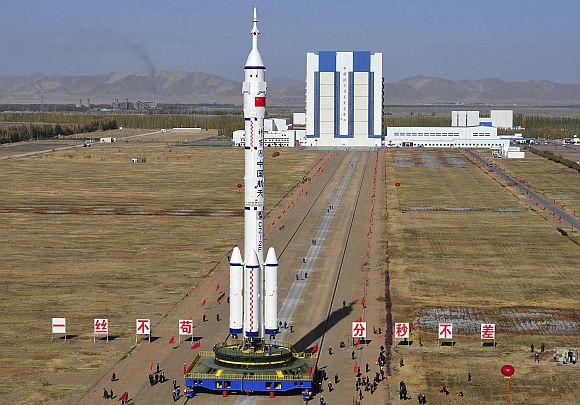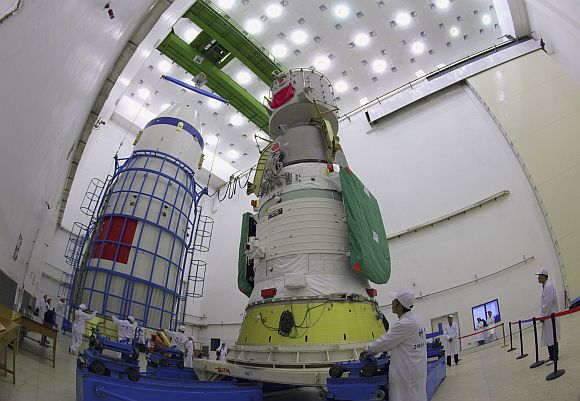Photographs: Reuters K J M Varma in Beijing
A Chinese unmanned spacecraft headed off to space on Tuesday for the country's first docking mission, paving the way for the establishment of China's first space station by 2020 to rival Mir, the space lab being operated by Russian and American astronauts.
The successful launch of unmanned spacecraft Shenzhou-8 in the early hours on Tuesday from Jiuquan Satellite Launch Center in northwest Gobi desert was successful, Commander-in-chief of China's manned space programme Chang Wanquan announced.
The spacecraft was sent into the designated orbit by Long March-2F rocket.
Click NEXT to view more amazing pictures...
China launches unmanned craft; nears space station dream
Image: Employees transfer the Long March II-F rocket to the launchpad in the Jiuquan Satellite Launch CenterPhotographs: Reuters
It is heading for rendezvous with Tiangong-1, or "the Heavenly Palace" that was put into space on September 29 for China's first space docking, which was expected to take place in the next two days.
The move, if successful, will pave the way for China to operate a permanent space station around 2020 and make it the world's third to do so after the United States and Russia. This will be the second space station after the Mir space lab launched in 2001 by Russia.
China launches unmanned craft; nears space station dream
Image: A Long March CZ-2F rocket carrying the unmanned spacecraft Shenzhou 8 blasts off from the launch pad at the Jiuquan Satellite Launch CenterPhotographs: Reuters
The docking of the Shenzhou-8 will take place at a height of 343 km above the Earth's surface. It will return to the Earth after two docking tryouts.
Chinese and German scientists will conduct 17 life science space experiments on the Chinese spacecraft Shenzhou-8, Wu Ping, spokeswoman for China's manned space programme, said.
To ensure the success of the mission, Chinese space engineers have made "considerable modifications" on Shenzhou-8 to previous versions of the spacecraft.
China launches unmanned craft; nears space station dream
Image: China's Vice Premier Zhang delivers a speech after the launch of China's unmanned spacecraft Shenzhou 8 at the Jiuquan Satellite Launch CenterPhotographs: Reuters
Shenzhou-8, with a length of nine metres and a maximum diameter of 2.8 metres, has a liftoff weight of 8.082 tonnes.
"More than half of the 600 or so sets of equipment have been modified, while newly designed devices account for about 15 per cent of the total," Wu said.
The modifications were mainly aimed at arming the spacecraft with automatic and manual rendezvous and docking capacities, and enhancing the vehicle's performance, safety and reliability, Wu said.
"After the improvements, the spacecraft will be able to connect with the target spacecraft Tiangong-1 for 180 days," Wu said.
The unmanned spacecraft is also equipped with devices for recording real images and mechanical parameters during its flight, to test the space docking before a manned attempt.
China launches unmanned craft; nears space station dream
Image: Video grab of astronaut Zhai Zhigang of China waving the national flag after exiting the Shenzhou VII space craftPhotographs: Reuters
Once China has mastered the technologies of rendezvous and docking, it will be equipped with the basic technologies and capacity required for building a space station, Zhou Jianping, chief designer of China's manned space programme said.
Today's mission will be followed by launches of spaceships Shenzhou-9 and 10 in 2012, which are also expected to dock with Tiangong-1.
"At least one mission of the two will be manned," Wu said.
China launches unmanned craft; nears space station dream
Image: Technicians prepare to assemble the cover of the Shenzhou-7 manned spacecraft at the Jiuquan Satellite Launch CenterPhotographs: Reuters
The crew members, including probably two female astronauts, have already been selected for the possible manual space docking mission in 2012 and are being trained for manual docking skills.
The space docking tests and experiments will provide crucial experience of China's construction of a 60-tonne permanent manned space station around 2020 when Chinese astronauts are expected to operate more research projects in space.
"It will make it possible for China to carry out space exploration of a larger scale," Zhou said.







article